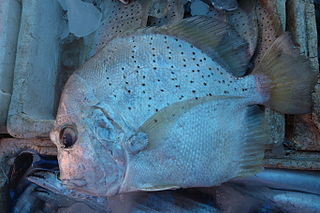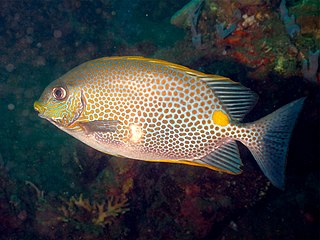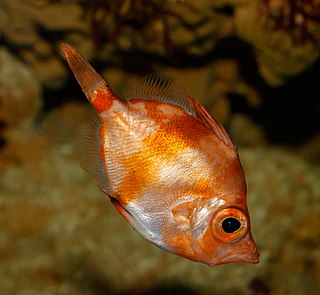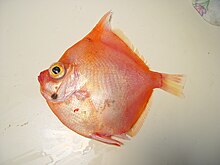
The Moorish idol is a species of marine ray-finned fish belonging to the family Zanclidae. It is the only member of the monospecific genus Zanclus and the only extant species within the Zanclidae. This species is found on reefs in the Indo-Pacific region.

The orbicular batfish, also known as the cooper batfish, circular batfish, orbiculate batfish, round batfish, narrow-banded batfish or orbic batfish is a species of marine ray-finned fish belonging to the family Ephippidae, the spadefishes and batfishes. This species is found in the Indo-Pacific but has been recorded outside its native range in the western Atlantic Ocean.

Caproidae, or boarfishes, are a small family of marine fishes comprising two genera and 19 species. These fishes are found throughout the world in temperate and tropical seas.

Antigonia is a genus of marine ray-finned fish belonging to the family Caproidae, the boarfishes. This genus is found in the warmer oceans around the world and is the only extant genus in the subfamily Antigoniinae.

Drepane is a genus of marine and brackish water ray-finned fishes, known commonly as the sicklefishes. It is the only genus in the monotypic percomorph family Drepaneidae. These fish occur in the Indian and western Pacific Oceans, and in the eastern Atlantic near Africa.

Scatophagidae, the scats are a small family of ray-finned fishes in the order Perciformes. They are found in the Indo-Pacific region but one species has been introduced elsewhere.

Acanthurus achilles, the Achilles tang, redtail surgeonfish or redspot surgeonfish, is a marine ray-finned fish belonging to the family Acanthuridae, the surgeonfishes, unicornfishes and tangs. This fish is found in the Pacific Ocean.

The orange-spotted spinefoot, also known as the deepbody spinefoot, gold-saddle rabbitfish, golden rabbitfish, golden-spotted spinefoot, goldlined spinefoot or yellowblotch spinefoot, is a species of marine ray-finned fish, a rabbitfish belonging to the family Siganidae. It is found in the eastern Indian Ocean and western Pacific Ocean. It occasionally makes its way into the aquarium trade.

Naso minor, the blackspine unicornfish, slender unicornfish, lesser unicornfish or pony unicornfish, is a species of marine ray-finned fish belonging to the family Acanthuridae, the surgeonfishes, unicornfishes and tangs. This species is found in the Indo-Pacific region.

The reticulate unicornfishes is a species of marine ray-finned fish belonging to the family Acanthuridae, the surgeonfishes, unicornfishes and tangs. It is a rare species found on coral reefs in the Indo-West Pacific region.

Naso tuberosus, the humpnose unicornfish, is a species of marine ray-finned fish belonging to the family Acanthuridae, the surgeonfishes, unicornfishes and tangs. This species occurs in the Indian Ocean but it may be more widespread.

Prionurus is a genus of marine ray-finned fishes belonging to the family Acanthuridae, the surgeonfishes, unicornfishes and tangs, although some of the species in this genus are called sawtails or doctorfish. The species in this genus are found in the Pacific Ocean with one species, P. biafraensis, found in the Atlantic Ocean.

Prionurus laticlavius the razor surgeonfish or razor sawtail, is a species of marine ray-finned fish belonging to the family Acanthuridae, the surgeonfishes, unicornfishes and tangs. This fish is found in the eastern central Pacific Ocean.

Capros aper, the boarfish or Zulu fish. is a species of marine ray-finned fish belonging to the family Caproidae. It is the only species in the monospecific genus Capros. The boarfish is found in the northeastern Atlantic Ocean and the Mediterranean.

Chaetodipterus is a genus of marine ray-finned fishes belonging to the family Ephippidae, the spadefishes. These fishes are found in the Atlantic and eastern Pacific Oceans.

Proteracanthus is a monospecific genus of marine ray-finned fish belonging to the family Ephippidae, the spadefishes and batfishes. The only species in the genus is Proeracanthus sarissophorus which occurs in coral reefs around Malaysia, Borneo, and Sumatra. This species is also known as the harpoon spadefish, or in Malaysia as drummer, knightfish, rudderfish or sea chub. This species grows to a length of 32.5 centimetres (12.8 in) SL.

Scatophagus is a genus of ray-finned fishes belonging to the family Scatophagidae. They are found in the Indo-Pacific region. Species in this genus are referred as spotted scats.

Siganus randalli, the variegated spinefoot or Randall's rabbitfish, is a species of marine ray-finned fish, a rabbitfish belonging to the family Siganidae. It is found in the Western Pacific Ocean.

Antigonia rubescens, the Indo-Pacific boarfish or sharpsnout deepsea boarfish, is a species of marine ray-finned fish belonging to the family Caproidae, the boarfishes. This fish is found in the Indo-West Pacific region.

Antigoniinae is a subfamily of marine ray-finned fishes belonging to the family Caproidae, the boarfishes. These fishes are found in the warmer oceans throughout the world.



















